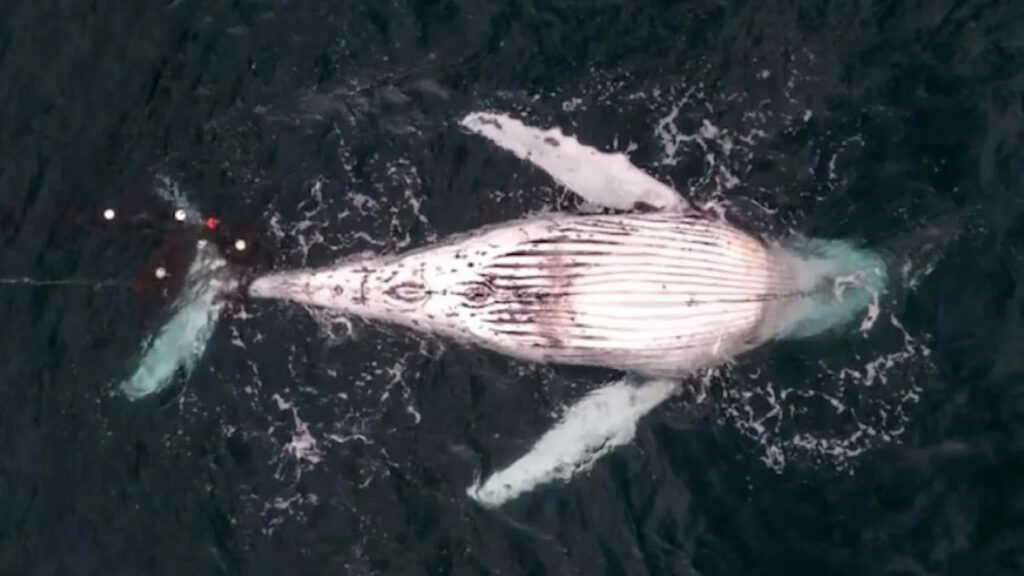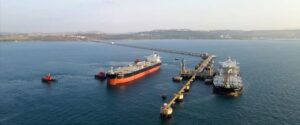
BREAKING: A juvenile humpback whale, measuring approximately 8 meters, was discovered dead after becoming entangled in a shark net off the coast of New South Wales, sparking national outrage over Australia’s shark control measures. The whale, believed to be around two years old, was found wrapped in netting between Coledale and Wombarra on 15 October 2023, marking the 15th whale entangled along Australia’s east coast this year and the first confirmed death.
Marine Rescue NSW inspector Stuart Massey confirmed that rescue crews had to abandon efforts to retrieve the whale due to hazardous sea conditions. “The plan was to take the carcass to a location where it could be removed from the water,” Mr. Massey stated. “Shortly before 3 PM, the combination of unfavourable sea conditions and proximity to rocks made it unsafe for our vessel and crew to remain there.” The whale later washed ashore on the night of 15 October.
Authorities from the NSW National Parks and Wildlife Service (NPWS), Organisation for the Rescue and Research of Cetaceans in Australia (ORRCA), and Marine Rescue NSW responded promptly to the incident. An NPWS spokesperson noted that the whale was “weaned and independent from its mother.” ORRCA president Ashley Ryan indicated that the whale was migrating south to Antarctica when it became trapped. “It does look like the whale has died after becoming caught in the shark net, but without performing a necropsy, we won’t be able to say for sure,” Ms. Ryan explained.
The incident has reignited discussions around the effectiveness of shark control programs, with Wollongong Greens councillor Jess Whittaker describing the event as “devastating.” “If it’s found that this whale has gotten caught in the shark net and struggled, that’s heartbreaking,” she told the ABC.
The whale was caught in the shark net at Coledale Beach, part of the Shark Meshing Bather Protection Program, which includes 51 nets deployed across the state. A spokesperson for the NSW Department of Primary Industries and Regional Development stated that the nets are fitted with acoustic “whale alarms” and “dolphin pingers” designed to deter marine mammals. However, conservationists argue that these technologies are ineffective and that the nets are outdated.
NSW Greens MP Cate Faehrmann condemned the incident as “absolutely heartbreaking,” emphasizing that the annual deployment of nets leads to the trapping, injury, or death of various marine species, including dolphins and endangered loggerhead turtles. Marine researcher Dr. Olaf Meynecke noted that juvenile whales are particularly vulnerable, stating, “A young whale would panic quite quickly, and if you’ve got high seas, there is the risk of drowning.”
Greens senator Peter Whish-Wilson called for a shift in strategy, urging governments to invest in modern alternatives like shark shields, drone surveillance, and public education, instead of continuing “the world’s longest marine cull.” This tragic discovery follows a series of whale entanglements off Queensland in September, including a mother and calf trapped for hours.
Conservation groups have long advocated for the replacement of shark nets with non-lethal technologies such as drone monitoring and enhanced beach alerts. In Queensland, RSPCA data shows that over 1,600 marine animals were captured by the shark control program last year, with more than 980 dying from drowning or injuries. Sea Shepherd Australia spokesman Jonathan Clark highlighted the urgent need for change, stating, “The lethal methods don’t protect people. We need shark nets removed and to focus on modern technologies.”
Wollongong City Council is set to oversee the removal of the whale carcass in the coming days, with ORRCA and NPWS conducting a necropsy to confirm the cause of death. This incident is a stark reminder of the ongoing struggle between marine conservation and public safety measures along Australia’s coast.







